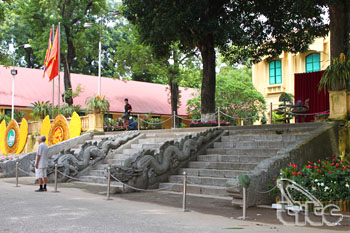Kinh Thien Palace was the centre of Imperial Citadel of Thang Long in Le Dynasty and Ha Noi Citadel in Nguyen Dynasty. The most important rituals of royal were held here.
In 1010, King Ly Thai To promulgated Chieu Doi Do (the royal decree) to change the capital from Hoa Lu (Ninh Binh Province) to Dai La Citadel. After transferring the capital, the king had Citadel of Thang Long built, of which the main palace of Can Nguyen was in the centre location, atop Long Do Mountain (Dragon’s navel). According to phong thuy (feng shui) principles and architectural practice, Long Do Mountain is a place of immense ritual power. In 1029, King Ly Thai Tong had Thien An Palace built on the foundation of Can Nguyen Palace. In 1428, King Le Thai To had Kinh Thien Palace built on the foundation of Thien An Palace and Kinh Thien Palace was considered as “one of the masterpieces of An Nam architectureâ€. In Nguyen Dynasty, when the capital was transferred to Hue, Kinh Thien Palace only acted as accommodation for Nguyen Kings during their trips to the North. In 1886, the French colonists destroyed Kinh Thien Palace, except two sets of stone dragon steps and had a house built on the foundation of the palace including 2 floors with 7 rooms. The house was used as French headquarters of artillery and called Dragon House because there are sets of stone dragon steps at the front and the back of the house. When Ha Noi was liberated in 1954, Dragon House became general headquarters of Vietnamese People's Army. It is now a relic of revolution and history, opened frequently for visitors.
 |
|
The set of stone dragon steps at the front of Dragon House |
Two sets of stone dragon steps in Kinh Thien Palace are the typical heritage of architecture and arts for Hau Le Dynasty. The set of dragon steps at the front built in 1467 includes nine stone steps, each step is 20cm high, 40cm wide, 13.6m long. The steps are divided into three flights separated by two stone dragons. The centre flight was reserved for king, while two flanking ones were for mandarins. The two dragons are beautifully sculpted. Their heads - at the first step - are very large, their body are tapering as they follow the ascent of the steps until they form a sword shape at the top. Each dragon has five claws, symbolizing royal power. There are two banisters at two sides of the set of dragon steps made of monoliths with length of 5.3m, width of 36 - 39cm. Many vignettes are carved in these banisters.
The second set of dragon steps at the back constructed at the 17th – 18th centuries includes seven steps. Its scale is smaller than the set of steps at the front. There is only one flight created by two dragons at two sides of the set of dragon steps. Each dragon is 3.4m long with meticulous details including mouth holding a stone “pearlâ€, round nose, high forehead, branched horn, feet with five claws…
Four dragons in Kinh Thien Palace are also made of green stone and reflect partly monumental scale of former Kinh Thien Palace.
(Thuy Hang - TITC)